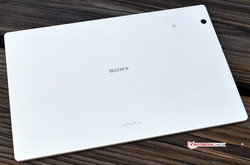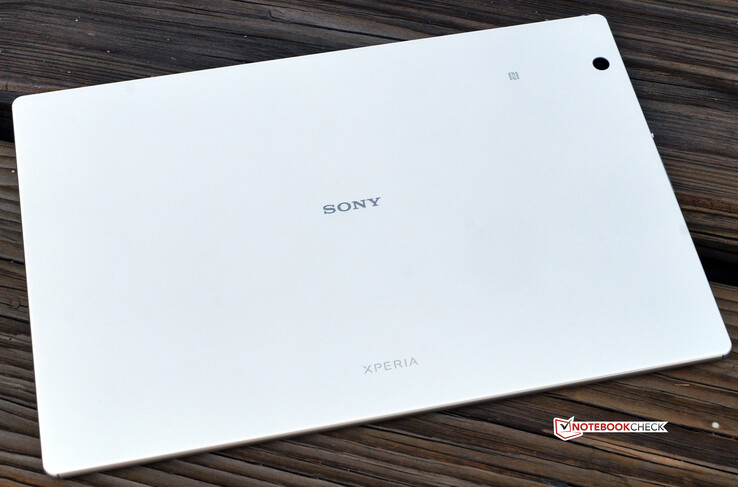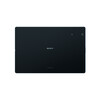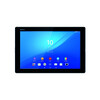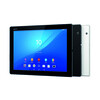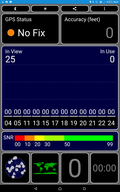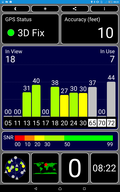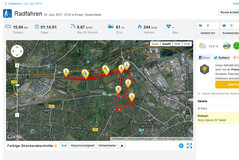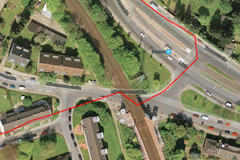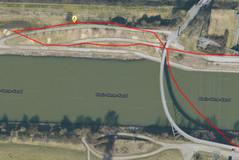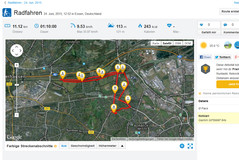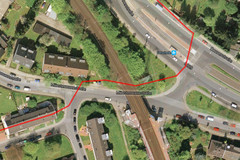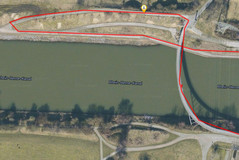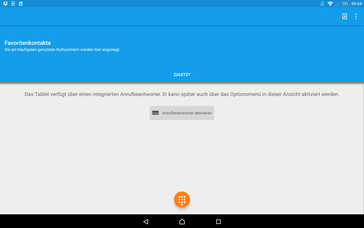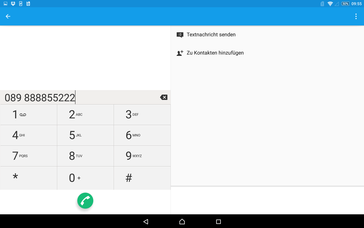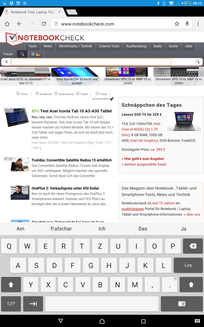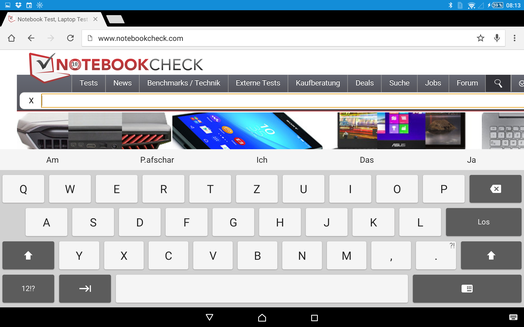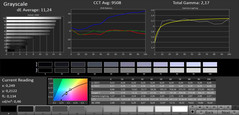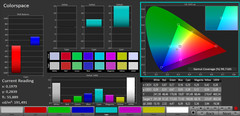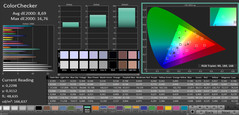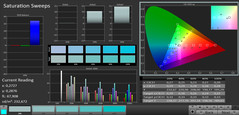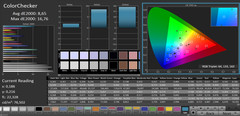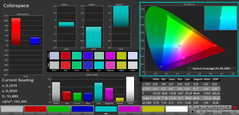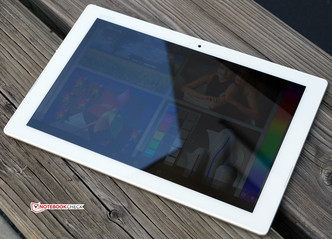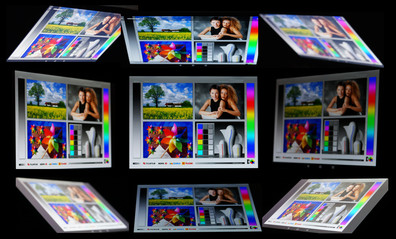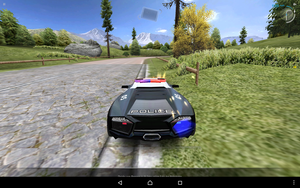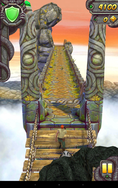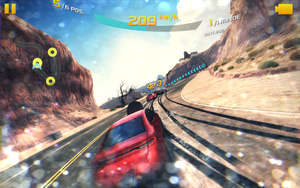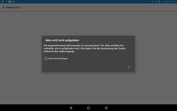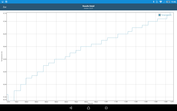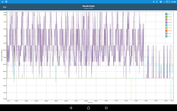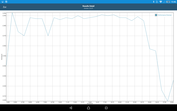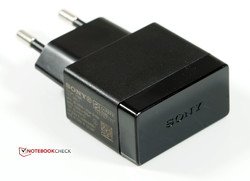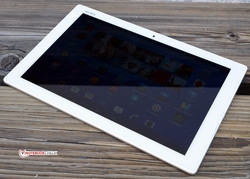Sony Xperia Z4 Tablet Review
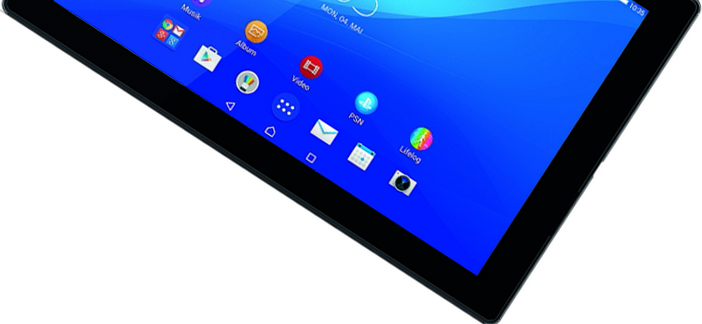
For the original German review, see here.
Tablets from the media giant Sony have had certain advantages for years now. This includes cases that are waterproof and dust-resistant, the lowest weight in their class and the thinnest construction. Those features were already convincing in the review of the Xperia Z2 Tablet, which is quite old now – but also with the camera modules that were really good for a tablet. Sony wants to keep familiar virtues for the new generation, but at the same time there are supposed to be improvements for important parts to compete with the current tablet elite. The Japanese use the currently fastest SoC from Snapdragon, waive some of the annoying water-protection covers at the case, once again reduce the height and the weight a bit, improve the cameras…and that’s pretty much it. Sony also improved the panel; the current generation of the Triluminos display now supports an ultra-high resolution as well. This means the Z4 Tablet gets 2560x1440 pixels and Sony still uses a 16:10 screen ratio.
Our review unit is equipped with an LTE modem and 32 GB storage. Sony charges 679 Euros (~$747) for this configuration, but you can save around 100 Euros (~$110) without the WWAN option. The device is available in black or white. Rivals for the latest top model from Sony are high-end tablets like the Apple iPad Air 2 as well as the Samsung Galaxy models Note 10.1 2014 and Tab S 10.5. There is even a competitor from Sony itself: The Sony Xperia Z3 Tablet Compact.
Case
A first look at the chassis of the Sony Xperia Z4 Tablet does not really reveal any significant changes. We were even tempted to refer to the review of the predecessor for this section. But this would have not been really fair to the new generation, since there are actually some positive as well as negative changes: First of all, Sony managed to make the thinnest 10-inch tablet even slightly thinner. Instead of 6.4 millimeters for the predecessor, the Z4 only measures just 6.1 millimeters. However, you can hardly notice the difference. It is even tricky to say which device is the thinnest when they are sitting next to each other. The main reason for that is the slightly arched frame of the Z4, while the frame of the Z2 is almost completely flat. The Japanese also managed to save some weight: At 393 grams, the tablet is really very light, and the Wi-Fi version is even 4 grams lighter. For comparison: The Apple iPad Air 2 is around 50 grams heavier. We think that the most interesting change at the chassis is the lack of the cover for the USB port against water and dust, which makes the handling much more convenient. MicroSD and Nano-SIM slot are still protected by a cover. The docking port was waived completely. Those were the positive changes. We already had to criticize the stability of the case in the review of the predecessor. The tablet is made from plastic and feels good in the hands thanks to its slightly roughened back, but twisting attempts will quickly result in picture distortions and quiet creaking. Another problem of the Z4 Tablet is that there are clearly audible cracking sounds when you apply a little bit more pressure, and you actually get the feeling that something inside the chassis broke. The facelift was not successful in this respect.
For more information we really want to refer to the review of the predecessor. The Z4 Tablet is also resistant against water.
Connectivity
When it launched, the components and features of the Sony Xperia Z2 Tablet were up to date. This also applies for the current top model from the Japanese, at least for the most part. Sony once again uses the fastest chip from Qualcomm that is currently available. The Snapdragon 810 has eight cores and uses the established big-LITTLE principle. The maximum clock is 2 GHz and the chip is supported by the Adreno 430 GPU, which is also known for its high performance. The rest of the components were not really changed by Sony. The amount of memory is still 3 GB, and the internal storage is 32 GB. The latter can still be expanded via microSD card by up to 128 GB. Installed apps can easily be transferred to the SD card if necessary. The multifunctional port is once again a USB 2.0 port with support for MHL 3.0 and OTG – exemplary.
Software
Operating system of the Sony Xperia Z4 Tablet is Android Lollipop 5.0.2, which is not the latest version, but you can still call the OS up to date. By the way: Lollipop was also rolled out for the predecessor of our review unit and for the Xperia Z3 Tablet Compact during the review period. Sony did not say anything about an update to Lollipop 5.1.x yet, but it should only be a matter of time.
Sony’s own user interface, which has a modern and simple design, is obviously installed on the Z4 Tablet as well. The music player is called "Walkman" and the pictures app "Album," which is typical for Sony. You also get some useful apps as well as some widgets. Nothing really changed from the predecessor in this section, so we once again refer to the review of the Z2 Tablet for more information.
Communication & GPS
The wireless communication modules of the Sony Xperia Z4 Tablet are up to date. The Wi-Fi module supports 2.4 and 5 GHz networks and manages theoretical transfer rates of up to 867 Mbps with ac Wi-Fi thanks to the MIMO technology. The signal strength is actually decent, but the signal was lost when a concrete wall was between the device and the router. The signal was fine on the floor with five rooms and a maximum distance of up to ten meters. Our review unit is equipped with a 4G module (LTE Cat. 6) for mobile Internet connections at up to 300 Mbps (downstream) and 50 Mbps (upstream), respectively. The signal quality and the transfer rates were very convincing in the Vodafone network.
Also available are the current Bluetooth standard 4.1, NFC and ANT+. The latter is primarily used for connection with sport and fitness gadgets.
The integrated aGPS receiver can communicate with the GPS satellite network and also with the Russian GLONASS as well as the Chinese Beidou networks. We could not establish a satellite fix indoors, but the initial location only took a couple of seconds outdoors.
We also took the tablet on a small bicycle ride and compared it with the professional navigation device Garmin GPSMAP 64s. The screenshots of the recorded tracks clearly show that the Z4 Tablet likes to take some shortcuts, especially in narrow turns. The tablet also lets us fly over the water occasionally. The professional navigation device also shows small deviations but is always much closer to the original track. The overall track length is around 200 meters shorter on the Z4, which is still okay. Street navigation is therefore no problem with Sony’s flagship tablet, but treasure hunting during geocaching might take a bit longer.
Telephone & Voice Quality
Sony also advertises the Xperia Z4 Tablet as a device to make calls. This does not only include VoIP calls via Skype, for example. The LTE module can also be used for voice calls, and the Japanese equipped the top tablet with the familiar phone app as well as an integrated answering machine from the Xperia smartphones. The handling is no problem and callers are easy to understand via internal speakers. Our voice, however, was very synthetic and distorted on the other side. It is not without reason that Sony recommends the use of a (its own) Bluetooth headset. However, the 10.1-inch tablet will hardly be used for normal calls, but the bad voice quality also affected the popular video chats.
Cameras & Multimedia
Many tablet manufacturers still ignore the topic of cameras. Okay, a 10-inch tablet will rarely be the only camera in a household, but you should still expect a decent picture quality nowadays. Sony already equipped the predecessor with better modules than most rivals, but the Z2 Tablet could not convince us completely, either. The light sensitivity of the cameras was pretty weak, and the last bit of sharpness was missing. Still, the Japanese did not change the main camera. The Z4 Tablet once again uses an 8.1 MP sensor (3264x2448 pixels, 4:3) with a maximum sensitivity of ISO 3200. However, Sony improved the front camera and follows the selfie trend. The new sensor now takes pictures with up to 5.1 MP; the Z2 only had a 2 MP sensor. Both modules can record videos with up to 1080p Full HD.
The picture quality of the front camera was significantly improved compared to the predecessor. The higher resolution just shows more details, and the sharpness is generally higher. Colors appear much more vivid as well.
The specs of the main camera did not change, and the pictures are also very similar to the Xperia Z2 Tablet. The sharpness is even better than the front camera, but the pictures are still not razor-sharp and also pale because they lack dynamics. Diffuse light is also a challenge for the sensor and the results appear blurry as well as noisy. Despite these criticisms, the current top tablet from Sony is once again a better example in respect of the camera quality, but the Z4 still cannot replace a decent digital camera.
Accessories
Similar to almost every other tablet, the provided accessories are very limited. Besides the tablet itself, the simple box only accommodates a data/charging cable and a power adaptor that only has a nominal output of 7.5 Watts. We will soon find out that Sony saved money at the wrong end. The Japanese did not, however, save any paper, because there are numerous manuals and quick-start guides in the box.
What’s not in the scope of delivery can be certainly bought in Sony’s store for accessories. The products include headsets all the way up to keyboards and several covers, cases as well as protective display films. Here is the link for some shopping: Sony accessories for the Xperia Z4 Tablet.
Warranty
This section is pretty short: Sony grants a 24-month warranty. There are neither options nor extensions.
Input Devices & Handling
The touchscreen did not change compared to the predecessor, either. The touch-sensitive surface still measures 10.1-inches, recognizes up to ten inputs simultaneously and it works without any problems. Inputs are executed almost without delays, and the touchscreen is also sensitive in the peripheral areas. The scratch-proof protective glass layer probably does not offer the best gliding capabilities, but it is still okay. The same applies for the size and the function of the virtual keyboard. Sony uses its own layout, instead of using the Android Lollipop keyboard. We do not think this is a problem, quite the contrary: The large keys allow for a pretty high typing speed. The automatic word predictions above the keyboard are also useful pretty often.
There are only two control elements at the chassis: The power button, which is typical for Xperia devices, and a comparatively small volume rocker. Both can be used without problems and they provide a convenient pressure point. The Android buttons are displayed on the screen. This does cost some real estate but is usually no issue because apps like the camera or the video player can fade the symbols out.
Display
Sony usually does not participate in the race for the highest resolution with their smartphones and tablets. The recently launched smartphone flagship Xperia Z3 Plus from the Japanese, for example, still "only" uses an FHD display, while Samsung and LG already switched to WQHD. However, Sony now also follows the trend with its latest tablet device. WQXGA is the complicated designation for a resolution with 2560x1600 pixels, which results in a pixel density of 298 PPI. The resulting sharpness is visible right away, and aliasing or blurry objects are no problem for the Xperia Z4 Tablet.
Sony once again equips its latest tablet with a display from its Triluminos series, which is closely-related to IPS technology. But the Japanese did not only increase the resolution, they also improved a couple of key aspects. A maximum center brightness of 457 cd/m² is just slightly higher than the predecessor, but it is still well-suited for use in brighter environments. The black value is actually a bit lower, despite the increased luminance. Our test protocol says 0.46 cd/m², which results in a very good contrast ratio of 1,024:1. The very even brightness distribution is also very good at 92%. This means the Sony Xperia Z4 Tablet does not have to hide behind the strong competition, and it is actually one of the best tablet displays of all.
| |||||||||||||||||||||||||
Brightness Distribution: 92 %
Center on Battery: 471 cd/m²
Contrast: 1024:1 (Black: 0.46 cd/m²)
ΔE ColorChecker Calman: 8.69 | ∀{0.5-29.43 Ø4.79}
ΔE Greyscale Calman: 11.24 | ∀{0.09-98 Ø5}
99% sRGB (Argyll 1.6.3 3D)
Gamma: 2.17
CCT: 9508 K
| Sony Xperia Z4 Tablet Adreno 430, 810 MSM8994, 32 GB eMMC Flash | Sony Xperia Z2 Tablet Adreno 330, 801 APQ8074AB, 32 GB eMMC Flash | Sony Xperia Z3 Tablet Compact Adreno 330, 801 MSM8974AC, 16 GB eMMC Flash | Samsung Galaxy Note 10.1, 2014 Edition Adreno 330, 800 MSM8974, 16 GB eMMC Flash | Samsung Galaxy Tab S 10.5 Mali-T628 MP6, 5420 Octa, 16 GB eMMC Flash | Apple iPad Air 2 2014 PowerVR GXA6850, A8X, 128 GB eMMC Flash | |
|---|---|---|---|---|---|---|
| Screen | 11% | 4% | -5% | 15% | 9% | |
| Brightness middle (cd/m²) | 471 | 461 -2% | 531 13% | 414 -12% | 290 -38% | 423 -10% |
| Brightness (cd/m²) | 457 | 437 -4% | 518 13% | 385 -16% | 291 -36% | 427 -7% |
| Brightness Distribution (%) | 92 | 89 -3% | 91 -1% | 88 -4% | 87 -5% | 92 0% |
| Black Level * (cd/m²) | 0.46 | 0.59 -28% | 0.66 -43% | 0.84 -83% | 0.61 -33% | |
| Contrast (:1) | 1024 | 781 -24% | 805 -21% | 493 -52% | 693 -32% | |
| Colorchecker dE 2000 * | 8.69 | 3.55 59% | 6.29 28% | 4.11 53% | 2.37 73% | 2.86 67% |
| Greyscale dE 2000 * | 11.24 | 2.58 77% | 7.04 37% | 2.53 77% | 2.03 82% | 2.37 79% |
| Gamma | 2.17 101% | 2.78 79% | 2.78 79% | 2.4 92% | 2.45 90% | 2.43 91% |
| CCT | 9508 68% | 6342 102% | 8600 76% | 6722 97% | 6521 100% | 6941 94% |
| Color Space (Percent of sRGB) (%) | 99 | |||||
| Color Space (Percent of AdobeRGB 1998) (%) | 73.75 | 100 | 88 |
* ... smaller is better
The good measurements also result in a very convenient picture. Black content appears rich and brilliant. Colors are very intense but sometimes a bit too saturated. This is, however, no problem when you look at pictures, watch movies or play games. The visuals of moving content in particular benefit from the slight oversaturation.
More objective statements about the display quality can be made in combination with the colorimeter X-Rite i1Pro 2 as well as the software CalMAN. You can almost see a brutal blue up to purple cast with the factory settings. The option "White Balance" can be used to compensate for this issue, so you can get a pretty neutral adjustment. The colors also show a slightly higher deviation for blue colors. The color space of the display is, however, pretty wide and can cover almost the whole sRGB standard. ColorChecker also shows deviations for blue colors, so at least the factory settings are not very good. Still, this does not really affect the subjective picture impression.
Thanks to the high luminance, it is no problem to use the Sony Xperia Z4 Tablet outdoors. The reflections of the glass panel – especially if it is covered with fingerprints – are a much bigger issue and quickly mean that you cannot see the display content anymore.
The viewing-angle stability is very good, and even very flat angles do not result in color distortions. The brightness, however, is noticeably reduced when you surpass 45 degrees.
Performance
If a device wants to be high-end or a flagship it should come with the corresponding hardware. Sony does everything right for the Xperia Z4 Tablet, at least on paper. The Qualcomm Snapdragon 810 MSM8994 is without a doubt one of the fastest SoCs on the market right now. The 64-bit chip combines four fast Cortex A57 cores and four much more frugal A53 cores that are used depending on the load. The power cores run at up to 2 GHz, while the slower cores run at up to 1.5 GHz. If necessary, it is also possible that all cores work simultaneously, so the Snapdragon 810 deserves the title octa-core.
The SoC provides more than enough performance, which is also noticeable in the benchmarks. Still, the Sony Xperia Z4 only manages top results in some tests. It seems that there are once again temperature issues similar to the latest top smartphone from the Japanese. We will see that the Z4 Tablet also suffers from throttling over the course of the review. The resulting performance drop can explain the deficit to its own predecessor in Geekbench 3 and AndEBench, for example. Overall, the system performance is behind one or more – sometimes nominally weaker – rivals in almost all tests.
| Geekbench 3 | |
| 32 Bit Single-Core Score (sort by value) | |
| Sony Xperia Z4 Tablet | |
| Sony Xperia Z2 Tablet | |
| Sony Xperia Z3 Tablet Compact | |
| Samsung Galaxy Note 10.1, 2014 Edition | |
| Samsung Galaxy Tab S 10.5 | |
| 32 Bit Multi-Core Score (sort by value) | |
| Sony Xperia Z4 Tablet | |
| Sony Xperia Z2 Tablet | |
| Sony Xperia Z3 Tablet Compact | |
| Samsung Galaxy Note 10.1, 2014 Edition | |
| Samsung Galaxy Tab S 10.5 | |
| 64 Bit Single-Core Score (sort by value) | |
| Sony Xperia Z4 Tablet | |
| Apple iPad Air 2 2014 | |
| 64 Bit Multi-Core Score (sort by value) | |
| Sony Xperia Z4 Tablet | |
| Apple iPad Air 2 2014 | |
| AnTuTu v5 - Total Score (sort by value) | |
| Sony Xperia Z4 Tablet | |
| Sony Xperia Z3 Tablet Compact | |
| Apple iPad Air 2 2014 | |
| BaseMark OS II - Overall (sort by value) | |
| Sony Xperia Z4 Tablet | |
| Sony Xperia Z3 Tablet Compact | |
| Samsung Galaxy Tab S 10.5 | |
| Apple iPad Air 2 2014 | |
| PassMark PerformanceTest Mobile V1 - System (sort by value) | |
| Sony Xperia Z4 Tablet | |
| Samsung Galaxy Note 10.1, 2014 Edition | |
| Samsung Galaxy Tab S 10.5 | |
| Apple iPad Air 2 2014 | |
The graphics card Adreno 430 is, similar to the CPU, also one of the fastest chips on the market. It runs at up to 650 MHz, supports DirectX 11 as well as OpenCL 1.2 and it hardly has to fear competition at the moment. Only the ARM Mali-T760 MP8 is a little bit faster. Despite the 22 nm manufacturing, the Adreno 430 has problems with high temperature development, which already had some negative effects on the performance in some tests. Our benchmarks, however, are not really affected. 3DMark Ice Storm Unlimited determines a much higher Overall and Graphics score for the Z4 Tablet compared to the strong rivals. The Sony tablet does, however, fall on the last spot in the CPU-demanding Physics test, which is certainly caused by the increased SoC temperature.
| 3DMark | |
| 1280x720 offscreen Ice Storm Unlimited Score (sort by value) | |
| Sony Xperia Z4 Tablet | |
| Sony Xperia Z2 Tablet | |
| Sony Xperia Z3 Tablet Compact | |
| Samsung Galaxy Note 10.1, 2014 Edition | |
| Samsung Galaxy Tab S 10.5 | |
| Apple iPad Air 2 2014 | |
| 1280x720 offscreen Ice Storm Unlimited Graphics Score (sort by value) | |
| Sony Xperia Z4 Tablet | |
| Sony Xperia Z2 Tablet | |
| Sony Xperia Z3 Tablet Compact | |
| Samsung Galaxy Note 10.1, 2014 Edition | |
| Samsung Galaxy Tab S 10.5 | |
| Apple iPad Air 2 2014 | |
| 1280x720 offscreen Ice Storm Unlimited Physics (sort by value) | |
| Sony Xperia Z4 Tablet | |
| Sony Xperia Z2 Tablet | |
| Sony Xperia Z3 Tablet Compact | |
| Samsung Galaxy Note 10.1, 2014 Edition | |
| Samsung Galaxy Tab S 10.5 | |
| Apple iPad Air 2 2014 | |
| 2560x1440 Sling Shot OpenGL ES 3.0 (sort by value) | |
| Sony Xperia Z4 Tablet | |
| Apple iPad Air 2 2014 | |
| 2560x1440 Sling Shot Extreme (ES 3.1) (sort by value) | |
| Sony Xperia Z4 Tablet | |
| Apple iPad Air 2 2014 | |
| GFXBench 3.0 | |
| on screen Manhattan Onscreen OGL (sort by value) | |
| Sony Xperia Z4 Tablet | |
| Sony Xperia Z2 Tablet | |
| Sony Xperia Z3 Tablet Compact | |
| Samsung Galaxy Tab S 10.5 | |
| Apple iPad Air 2 2014 | |
| 1920x1080 1080p Manhattan Offscreen (sort by value) | |
| Sony Xperia Z4 Tablet | |
| Sony Xperia Z2 Tablet | |
| Sony Xperia Z3 Tablet Compact | |
| Samsung Galaxy Tab S 10.5 | |
| Apple iPad Air 2 2014 | |
| BaseMark OS II - Graphics (sort by value) | |
| Sony Xperia Z4 Tablet | |
| Sony Xperia Z3 Tablet Compact | |
| Samsung Galaxy Tab S 10.5 | |
| Apple iPad Air 2 2014 | |
The SoC does not seem to reach its thermal limits in the browser tests, and all the results are very good. The biggest rival for the Sony tablet within the comparison is the Apple iPad Air 2 – and it just loses the battle. It is even slightly ahead of the tablet from Cupertino in Mozilla Kraken.
| Octane V2 - Total Score (sort by value) | |
| Sony Xperia Z4 Tablet | |
| Sony Xperia Z2 Tablet | |
| Sony Xperia Z3 Tablet Compact | |
| Samsung Galaxy Tab S 10.5 | |
| Apple iPad Air 2 2014 | |
| Mozilla Kraken 1.1 - Total (sort by value) | |
| Sony Xperia Z4 Tablet | |
| Sony Xperia Z2 Tablet | |
| Sony Xperia Z3 Tablet Compact | |
| Samsung Galaxy Note 10.1, 2014 Edition | |
| Samsung Galaxy Tab S 10.5 | |
| Apple iPad Air 2 2014 | |
| Browsermark - 2.1 (sort by value) | |
| Sony Xperia Z4 Tablet | |
| Sony Xperia Z3 Tablet Compact | |
| Samsung Galaxy Tab S 10.5 | |
| Apple iPad Air 2 2014 | |
| Sunspider - 1.0 Total Score (sort by value) | |
| Sony Xperia Z4 Tablet | |
| Sony Xperia Z2 Tablet | |
| Sony Xperia Z3 Tablet Compact | |
| Samsung Galaxy Note 10.1, 2014 Edition | |
| Samsung Galaxy Tab S 10.5 | |
| Apple iPad Air 2 2014 | |
| BaseMark OS II - Web (sort by value) | |
| Sony Xperia Z4 Tablet | |
| Sony Xperia Z3 Tablet Compact | |
| Samsung Galaxy Tab S 10.5 | |
| Apple iPad Air 2 2014 | |
| Peacekeeper - --- (sort by value) | |
| Sony Xperia Z4 Tablet | |
| Sony Xperia Z2 Tablet | |
| Sony Xperia Z3 Tablet Compact | |
| Samsung Galaxy Note 10.1, 2014 Edition | |
| Samsung Galaxy Tab S 10.5 | |
| Apple iPad Air 2 2014 | |
* ... smaller is better
The internal storage capacity of the Sony Xperia Z4 Tablet is just 32 GB, but that does not mean it isn’t fast. Both AndroBench 3 as well as the storage test of Basemark OS II determine an impressive storage performance for the 10.1-inch device. It is also worth mentioning that the 4k performance is not dropping as extremely compared to many tablets or smartphones.
| BaseMark OS II - Memory (sort by value) | |
| Sony Xperia Z4 Tablet | |
| Sony Xperia Z3 Tablet Compact | |
| Samsung Galaxy Tab S 10.5 | |
| Apple iPad Air 2 2014 | |
Games
Thanks to one of the fastest GPUs for a tablet right now, the Sony Xperia Z4 Tablet is basically powerful enough for every current and upcoming 3D game in the near future. However, the Z4 Tablet has thermal issues that can actually result in throttling when you play demanding games, but we had no problems during our review period. All games that we tested ran completely smooth, even at the highest settings. The well-working position sensor and accelerometer as well as the precise touchscreen complement the great gaming experience.
Emissions
Temperature
Not only the summer annoys us with record temperatures at the moment, the Sony Xperia Z4 also has to fight with high temperatures. We can already measure values of up to 40 °C while idling. The predecessor was still around 10 °C cooler – a huge difference. The temperature development is an even bigger problem under load and up to 47 °C at the back of the Z4 Tablet is already inconveniently hot.
We want to mention the throttling in this section again. We checked it with the battery test of the GFX Benchmark 3.0. It runs the T-Rex test thirty times in a row and logs both the temperatures as well as the performance. The screenshots clearly show that the performance already starts to fluctuate after a couple of runs, before it drops dramatically at the end. The temperature also increases at the same time. All in all, this phenomenon affects the overall performance and could result in some stutters when you play very demanding titles. However, the temperature issue is not as bad compared to the recently reviewed Sony Z3+, but we still deduct points in the temperature ranking.
(±) The maximum temperature on the upper side is 40.7 °C / 105 F, compared to the average of 33.7 °C / 93 F, ranging from 20.7 to 53.2 °C for the class Tablet.
(-) The bottom heats up to a maximum of 47.4 °C / 117 F, compared to the average of 33.2 °C / 92 F
(±) In idle usage, the average temperature for the upper side is 35 °C / 95 F, compared to the device average of 30 °C / 86 F.
Speakers
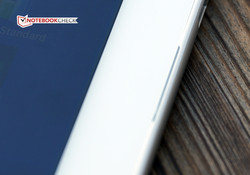
Similar to the Z2 Tablet, the stereo speakers are at the front of the Xperia Z4 Tablet. Sony did, however, shift them a bit further to the top on the new model, so they cannot be covered by the hands as quickly during gaming. The sound is pretty good. Both speakers manage a decent volume, but the distortions are not too bad. Medium and high tones are differentiated enough, but bass is missing due to the construction. Thanks to numerous settings, the sound can be easily adjusted to your personal preferences, and it is even possible to get some kind of surround sound as well as a bit more depth for the bass.
Energy Management
Power Consumption
We cannot make any useful statements in this section this time, because our measurements, unfortunately, produced results that have nothing to do with reality. The standby value was as high as the consumption of other tablets at the maximum brightness. The maximum consumption was far below the expectations. There is one thing we can say for sure: The provided 7.5-Watt power adaptor is clearly not powerful enough. We often got the message that the battery was not charged anymore during benchmarks and games. The battery capacity even decreased under sustained load.
Battery Runtime
Due to the lack of consumption values we cannot say anything about the expected runtimes. The battery of the Sony Xperia Z4 Tablet is pretty small at 21.6 Wh and 6,000 mAh, but the manufacturer still advertises a runtime of up to 17 hours during video playback, which is more than ambitious. We start with the maximum runtime at the minimum brightness setting, activated energy-saving features and the activated flight mode. We only turn the Wi-Fi module on by hand to use our automated reading script from the server. The runtime of 35.5 hours is pretty impressive and easily beats all the rivals. The situation changes completely under load: The tablet turns off after just three hours while we ran the app Stability Test with the highest luminance and all activated communication modules. This time, all the rivals have more stamina, but this scenario is not very realistic. A more practical test is our Wi-Fi scenario, where a script opens a new website in the browser every 30 seconds. The brightness is adjusted to 150 cd/m², and energy-saving features are active. The result is, unfortunately, not very convincing, 8 h 45 m is far worse than some devices like the Samsung Galaxy Note 10.1 2014 or Sony’s own Xperia Z3 Tablet Compact. Both rivals were, however, still tested with the old Wi-Fi test, where the runtimes are about 10% longer.
Finally, we check the runtime during video playback. We use the license-free movie Big Buck Bunny in 1080p (H.264) and run it in a loop with the app Video Looper. All communication modules are turned off and the brightness is adjusted to 150 cd/m². The result of almost 12 hours for the Z4 Tablet is once again not really impressive and also not even close to the claimed runtime of 17 hours. This means the battery runtimes are all in all just average – at least compared to other high-end tablets. The Apple iPad Air 2 and the Samsung Galaxy Note 101 2014, however, are at least pretty much on par with the Z4 Tablet.
It requires patience when you want to charge the Sony Xperia Z4 Tablet: A complete recharge takes 5 h 50 m. This is really a long time and once again shows that the provided power adaptor is not powerful enough.
| Sony Xperia Z4 Tablet Adreno 430, 810 MSM8994, 32 GB eMMC Flash | Sony Xperia Z2 Tablet Adreno 330, 801 APQ8074AB, 32 GB eMMC Flash | Sony Xperia Z3 Tablet Compact Adreno 330, 801 MSM8974AC, 16 GB eMMC Flash | Samsung Galaxy Note 10.1, 2014 Edition Adreno 330, 800 MSM8974, 16 GB eMMC Flash | Samsung Galaxy Tab S 10.5 Mali-T628 MP6, 5420 Octa, 16 GB eMMC Flash | Apple iPad Air 2 2014 PowerVR GXA6850, A8X, 128 GB eMMC Flash | |
|---|---|---|---|---|---|---|
| Battery runtime | 43% | 55% | 68% | 28% | 3% | |
| H.264 (h) | 11.8 | 14.6 24% | 14.5 23% | 6.6 -44% | 9.4 -20% | |
| WiFi v1.3 (h) | 8.8 | |||||
| Load (h) | 2.8 | 4.5 61% | 5.2 86% | 4.7 68% | 5.6 100% | 3.5 25% |
| WiFi (h) | 9.8 | 14 | 18.4 | 10 | 10.5 |
Pros
Cons
Verdict
Thin, light, waterproof, powerful and top features – this is familiar for Sony tablets nowadays. All these characteristics also apply for the Xperia Z4 Tablet. This could already be the end of the verdict, if there weren’t some issues. But let’s start with the good things about the flagship device from Sony: The Japanese managed to make the Z4 even thinner and lighter compared to its predecessor, and the top model from Sony actually feels like a featherweight for a 10-inch tablet. The build quality is at least visually flawless. Sony does not use any metal, but the plastic chassis still feels sophisticated in the hands and does not slip easily, either.
The Japanese use everything you can currently get for the connectivity: Very fast SoC, a lot of RAM, expandable internal storage and very fast communication modules. This is accompanied by a bright, high-contrast and high-resolution display, usable cameras and two decent speakers. The performance of the Xperia Z4 Tablet is mainly convincing, and it is almost too powerful in practice…
…but the tablet cannot always utilize this performance. Similar to its smartphone sibling Xperia Z3 Plus, the Z4 Tablet suffers from thermal issues. The resulting heat does not only result in a very warm chassis. The performance is also affected after a while. It seems that Sony is not able to handle the heat, which is pretty much the only explanation when two high-end devices suffer from the same phenomenon. The weak power adaptor should not get by a working quality control, either. The results are annoyingly long charging times and it is not even powerful enough to charge the battery when you use the tablet. It is even worse: The battery capacity decreases. It is also unfortunate that the stability of the chassis suffers from the dimensions. We would have expected more. The battery runtimes are only average, at least under practical conditions. These flaws are also the reason that the Sony Xperia Z4 Tablet cannot secure a spot in our Top 10 ranking.
This means our verdict must be: The Sony Xperia Z4 Tablet is a tablet with great features and a very low weight. The lacking stability and the thermal issues, however, have to be considered before you buy the device. Those flaws should not be a problem for a device that retails for 700 Euros (~$770).
Sony Xperia Z4 Tablet
- 07/10/2015 v4 (old)
Patrick Afschar Kaboli




